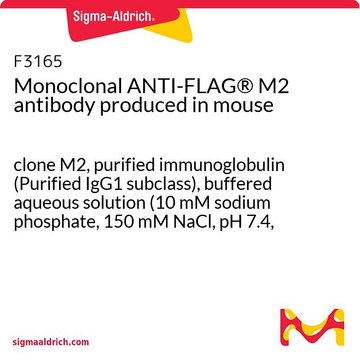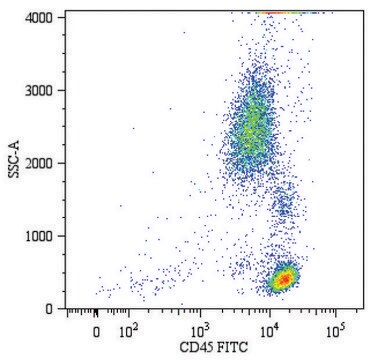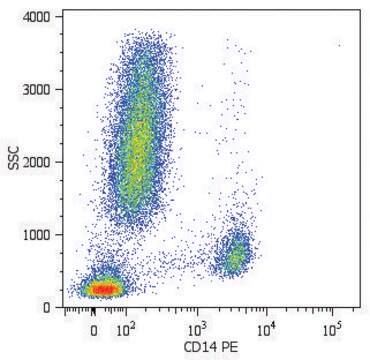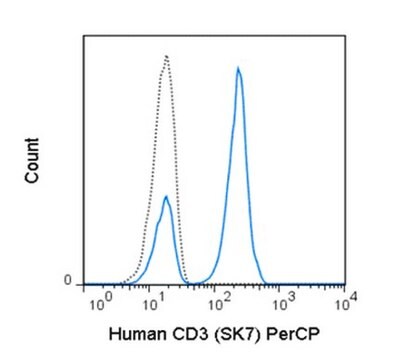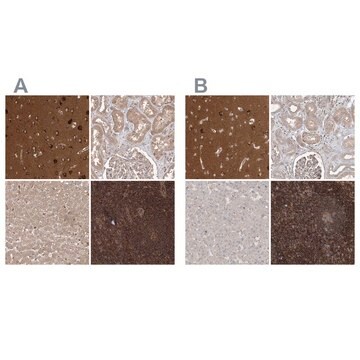SAB4700164
Monoclonal Anti-CD34-PE antibody produced in mouse
clone 4H11[APG], purified immunoglobulin, buffered aqueous solution
Sinônimo(s):
Anti-Mucosialin
Faça loginpara ver os preços organizacionais e de contrato
About This Item
Código UNSPSC:
12352203
NACRES:
NA.44
Produtos recomendados
fonte biológica
mouse
Nível de qualidade
conjugado
phycoerythrin (R-PE) conjugate
forma do anticorpo
purified immunoglobulin
tipo de produto de anticorpo
primary antibodies
clone
4H11[APG], monoclonal
Formulário
buffered aqueous solution
reatividade de espécies
human
técnica(s)
flow cytometry: suitable
Isotipo
IgG1
nº de adesão NCBI
nº de adesão UniProt
Condições de expedição
wet ice
temperatura de armazenamento
2-8°C
modificação pós-traducional do alvo
unmodified
Informações sobre genes
human ... CD34(947)
Descrição geral
The antibody 4H11[APG] reacts with Class III epitope on CD34 (Mucosialin), a 110-115 kDa monomeric transmembrane phosphoglycoprotein expressed on hematopoietic progenitors cells and on the most pluripotential stem cells; it is gradually lost on progenitor cells. The antibody 4H11[APG] completely blocks binding of Class II antibody QBEnd10 and Class III antibodies BIRMA K3 and 8G12 on KG1a cell line.
Imunogênio
Permanent human cell line derived from peripheral leucocytes of a patient suffering from chronic myeloid leukaemia.
Aplicação
The reagent is designed for Flow Cytometry analysis of human blood cells using 20 μL reagent / 100 μL of whole blood or 1e6 cells in a suspension. The content of a vial (2 mL) is sufficient for 100 tests.
Características e benefícios
Evaluate our antibodies with complete peace of mind. If the antibody does not perform in your application, we will issue a full credit or replacement antibody. Learn more.
forma física
Solution in phosphate buffered saline containing 15 mM sodium azide and 0.2% high-grade protease free BSA as a stabilizing agent.
Exoneração de responsabilidade
Unless otherwise stated in our catalog or other company documentation accompanying the product(s), our products are intended for research use only and are not to be used for any other purpose, which includes but is not limited to, unauthorized commercial uses, in vitro diagnostic uses, ex vivo or in vivo therapeutic uses or any type of consumption or application to humans or animals.
Não está encontrando o produto certo?
Experimente o nosso Ferramenta de seleção de produtos.
Código de classe de armazenamento
10 - Combustible liquids
Classe de risco de água (WGK)
WGK 2
Ponto de fulgor (°F)
Not applicable
Ponto de fulgor (°C)
Not applicable
Escolha uma das versões mais recentes:
Já possui este produto?
Encontre a documentação dos produtos que você adquiriu recentemente na biblioteca de documentos.
Melanie Werner-Klein et al.
PloS one, 9(5), e97860-e97860 (2014-05-17)
Tumor xenografts in immunodeficient mice, while routinely used in cancer research, preclude studying interactions of immune and cancer cells or, if humanized by allogeneic immune cells, are of limited use for tumor-immunological questions. Here, we explore a novel way to
K Elknerová et al.
Neoplasma, 54(4), 311-320 (2007-09-08)
Growth-inhibitory and proapoptotic effects of the monoclonal antibody to CD34 molecule, clone 4H11, were tested in CD34+ leukemic cell lines (MOLM-9, JURL-MK1, HEL) and CD34- cell lines (PS-1, ML-2 and CTV-1). We have found that the monoclonal antibody to CD34
Libing Wang et al.
Annals of hematology, 93(10), 1685-1694 (2014-05-23)
Acute myeloid leukemia (AML) is generally regarded as a disorder of stem cells, known as leukemic initiating cells (LICs), which initiate the disease and contribute to relapses. Although the phenotype of these cells remains unclear in most patients, they are
Mirelle J A J Huijskens et al.
Journal of leukocyte biology, 96(6), 1165-1175 (2014-08-27)
The efficacy of donor HSCT is partly reduced as a result of slow post-transplantation immune recovery. In particular, T cell regeneration is generally delayed, resulting in high infection-related mortality in the first years post-transplantation. Adoptive transfer of in vitro-generated human
Global Trade Item Number
| SKU | GTIN |
|---|---|
| SAB4700164-100TST | 4061838165374 |
Nossa equipe de cientistas tem experiência em todas as áreas de pesquisa, incluindo Life Sciences, ciência de materiais, síntese química, cromatografia, química analítica e muitas outras.
Entre em contato com a assistência técnica

